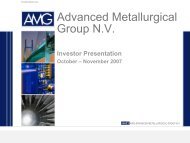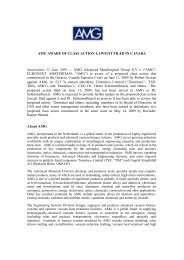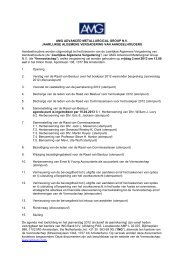C Si Ni Cr V Ti Ta Sc Li Sr Zr Fe Cu Zn Sn B Al Ce U Mn Mo Nb Sb
C Si Ni Cr V Ti Ta Sc Li Sr Zr Fe Cu Zn Sn B Al Ce U Mn Mo Nb Sb
C Si Ni Cr V Ti Ta Sc Li Sr Zr Fe Cu Zn Sn B Al Ce U Mn Mo Nb Sb
You also want an ePaper? Increase the reach of your titles
YUMPU automatically turns print PDFs into web optimized ePapers that Google loves.
Risk Management and Internal Controls<br />
Risk Management Approach<br />
AMG employs a traditional risk management approach,<br />
including a ‘top-down’ and ‘bottom-up’ analysis and assessment<br />
of the Company’s risks. Appropriate and diverse<br />
lines of property and liability insurance coverage are also<br />
an integral part of this risk management program. AMG<br />
has implemented a comprehensive risk management<br />
program centered on the Company’s Risk Assessment<br />
Package (“RAP”). The RAP is a detailed document requiring<br />
each business unit to:<br />
(i) identify potential risks and quantify the impact of<br />
such risks;<br />
(ii) prioritize the risks using a ranking system to determine<br />
the impact, likelihood and suddenness of<br />
occurrence;<br />
(iii) describe the risk mitigation or transfer procedures in<br />
place; and<br />
(iv) document the periodic monitoring of the risks.<br />
Each business unit undertakes a full review of its RAP on<br />
a quarterly basis. The RAPs are then reviewed in detail<br />
by AMG’s Risk Manager in coordination with the operating<br />
managers of the business units. Key risks from all<br />
business units are then summarized and presented to the<br />
Management Board. Individual risks of special note are<br />
discussed at the Management Board’s bi-weekly meeting.<br />
The Management Board has the responsibility to inform<br />
the Supervisory Board of the most significant risk exposures<br />
and the related risk management plans in place.<br />
The Audit Committee of the Supervisory Board carries out<br />
a semi-annual review of the Company’s internal control<br />
and risk management program. As in previous years,<br />
AMG’s Management Board and operating managers of<br />
business units evaluated the Company’s risk management<br />
activities during 2010. As was the case in 2009, the<br />
Company’s Internal Audit Director was in place for the full<br />
calendar year 2010. During 2010, special attention was<br />
given to:<br />
(i) refinancing the credit facility;<br />
(ii) credit facility amendments;<br />
(iii) liquidity management;<br />
(iv) Code of Conduct education, including a training<br />
course in General Antitrust Principles and Practices<br />
for select employees; and<br />
(v) Information Technology improvements.<br />
Risks<br />
Risks faced by AMG can broadly be categorized as:<br />
• Strategic: includes risks related to marketing and sales<br />
strategy, product innovation, technology innovation,<br />
overall raw material sourcing decisions, capacity decisions<br />
and acquisitions<br />
• Operational: includes risks related to executing the<br />
strategic direction, supply of raw materials, production,<br />
maintenance of production equipment, distribution of<br />
products, labor relations, human resources, IT infrastructure,<br />
health, safety and environmental, and sales<br />
and marketing<br />
• Market and External: includes risks related to global<br />
and regional economic conditions, market supply/<br />
demand characteristics, metal prices, product substitution,<br />
customer and competitor actions and community<br />
relations<br />
• Financial: includes risks related to accuracy and<br />
timeliness of financial reporting, compliance with<br />
IFRS accounting standards, compliance with AFM and<br />
Euronext Amsterdam requirements, compliance with<br />
credit facility covenants, currency fluctuations, liquidity,<br />
refinancing, budgeting, metal price and currency hedging,<br />
treasury and tax functions<br />
• Legal and Regulatory: includes risks related to the<br />
political, environmental, legislative, and corporate<br />
governance environment<br />
AMG, like most industrial companies, faces a combination<br />
of risks. The largest risks faced by the Company evolve<br />
throughout each calendar year and cannot be viewed as<br />
static challenges. It is not the intention to detail each risk<br />
posed to AMG in this report, but the most pertinent risks<br />
to the business are described below in no particular order.<br />
Report of the Management Board | Risk Management and Internal Controls 33







